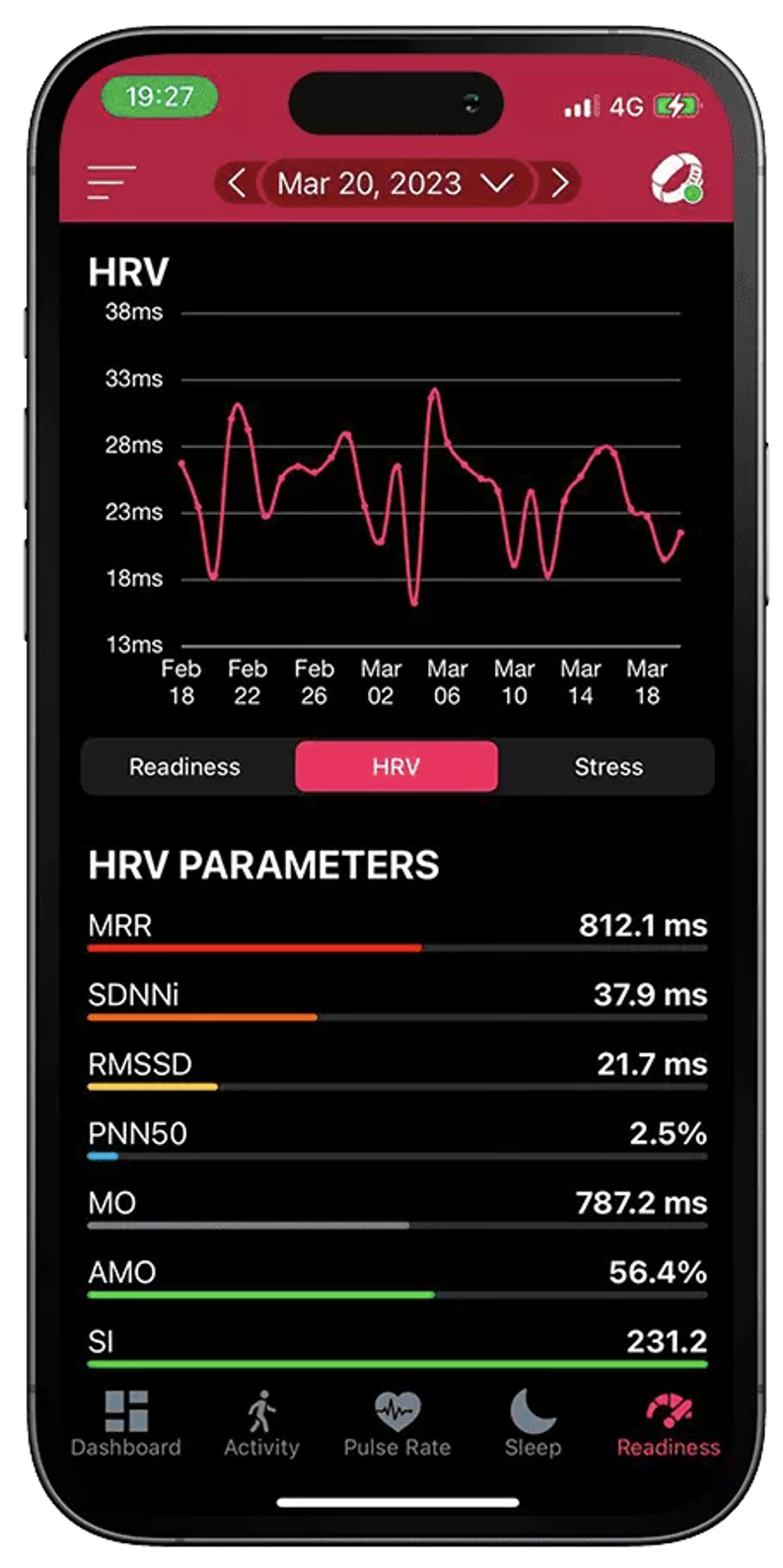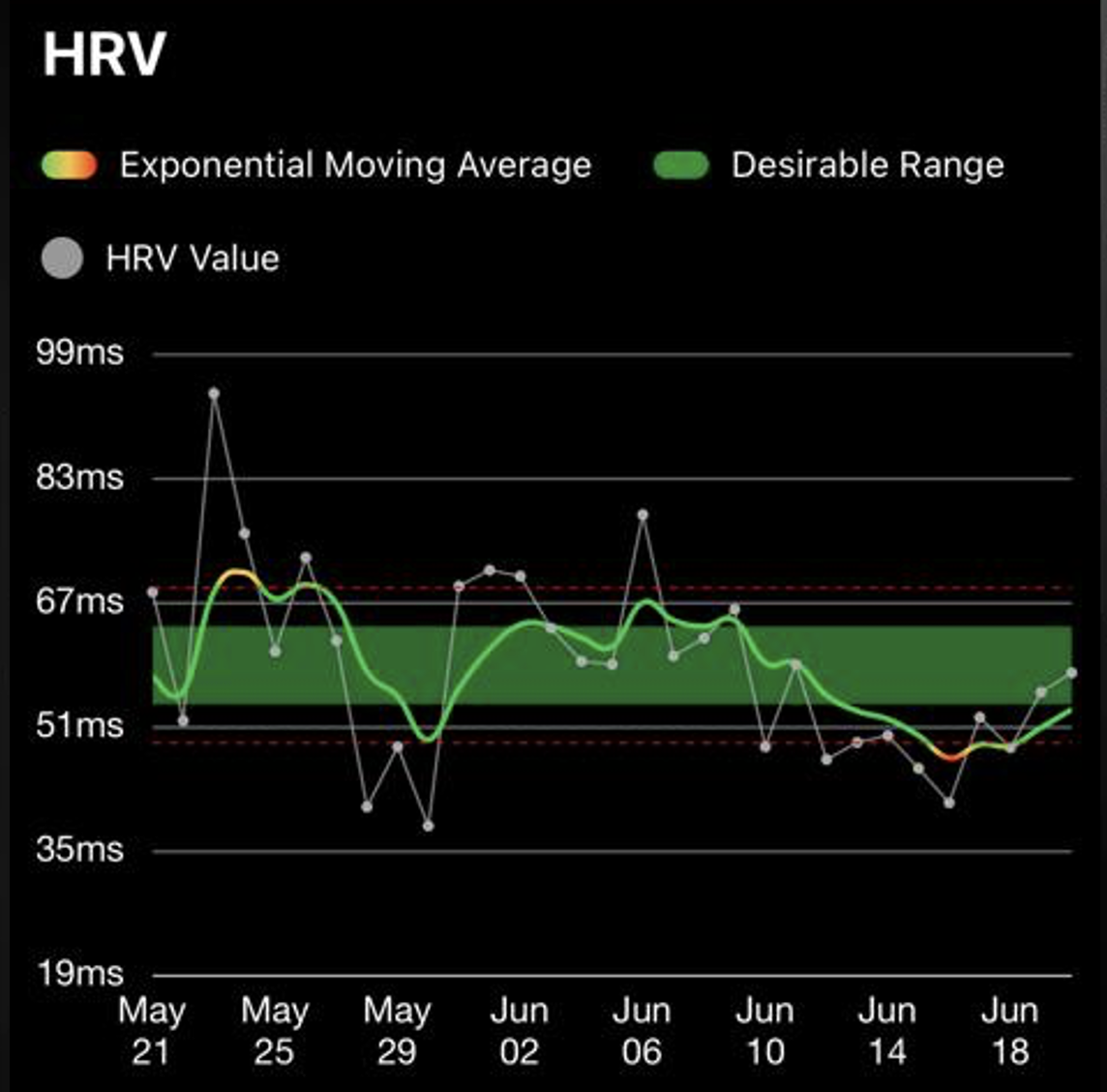Improve HRV
HRV WHAT IS IT? AND HOW TO INCREASE IT?
Heart Rate Variability refers to the constant variation in milliseconds between your heartbeats. As popular as the metaphor may be, a healthy heart doesn’t beat as regularly as a metronome—it changes its rhythm with each beat. Some situations increase variation (high HRV), while others cause the intervals between beats to remain constant (low HRV).
You may be unaware of these subtle variations, but they reflect your heart’s ability to respond to different situations. HRV can react to stress and/or illness before resting heart rate (RHR), which makes it one of your body’s most powerful signals—providing useful insights into your stress levels, recovery status, and general well-being. As a rule of thumb, high HRV is associated with rest-and-digest, general fitness, and good recovery, while low HRV is associated with fight-or-flight, stress, illness, or overtraining.

While individual days may be lower after high-intensity exercise, a night out, or a stressful day, if your recent HRV is on par with or better than your average, it’s a sign of good recovery. Monitoring HRV trends shows whether you are adapting or not to the “load” you are exposed to. This load could be new medications or treatment plans, or an increase in training load.
Finally, one person’s HRV should not be compared with another’s. HRV is very personal. The key is to track trends over time. The coefficient of variation of HRV is a great metric to focus on as it removes the daily variations and helps you focus on the bigger picture.
Moving the needle – How to increase HRV

Physical Activity
HRV tends to decline with age. The most effective way to hedge this decline is cardiovascular exercise. No other lifestyle change comes close to cardio.
Take a breath
Biofeedback, coupled with controlled breathing can affect both short and long term HRV.
Sleep Optimization
Poor sleep hygiene can negatively affect HRV over the short term. So try to avoid late exercise, meals, and dramatically reduce or eliminate alcohol, which is the single worst thing for HRV.
Stay Hydrated
It is well known that modern man does not drink enough water as we should. Sufficient hydration aids with thermoregulation and can help increase HRV at least temporarily.
Energy Resources
Meditation is another protocol that calms one’s mind and puts you into a parasympathetic state. Meditation has been shown to have a short term effect on HRV.
Exponential Moving Average
In today’s digital age, where data plays an increasingly important role in our lives, new ways of understanding and visualizing that data are constantly being developed. One area that can greatly benefit from advanced data visualization is healthcare. HRV data is often collected over time and can be difficult to interpret when presented in its raw form. That’s where the Exponential Moving Average (EMA) comes in.
While connecting individual data points might seem like a simple, straightforward way to track progress, it may not provide the most accurate picture of your HRV. Exponential Moving Average (EMA) is a statistical tool used to smooth out fluctuations in a dataset by assigning exponentially decreasing weights to older observations. This technique results in a more accurate representation of trends in the dataset without the noise associated with day-to-day variability.
EMA=Data point(t)×k+EMA(y)×(1−k)
Where:
t=today
y=yesterday
N=number of days in EMA
k=2÷(N+1)
Here’s why EMA outshines traditional methods when it comes to displaying health data.
Reduces Noise: When tracking HRV, daily variations can create “noise” that makes it challenging to identify patterns or trends. By using EMA, these fluctuations become less significant due to the weighted smoothing process applied across multiple days. As a result, you gain clarity on underlying trends and can make more informed decisions based on your health goals.
Responsive to Recent Changes: Unlike simple moving averages (SMA), which give equal weightage to all observations within a specified range, EMA puts more emphasis on recent data points. This allows EMA to be more responsive to changes in your health metrics, providing you with a better understanding of your current state of wellbeing.
Easily Adaptable: EMA can be easily tailored to suit individual needs by adjusting the smoothing factor. A higher smoothing factor will result in a more stable representation that is less sensitive to short-term fluctuations, while a lower factor will produce a more responsive visualization that rapidly adapts to changes in the data.
Continuous Analysis: Traditional methods of connecting data points often require waiting for new observations before updating the analysis. EMA, on the other hand, can be updated at any time using available data points, allowing for consistent monitoring and analysis of health trends.

